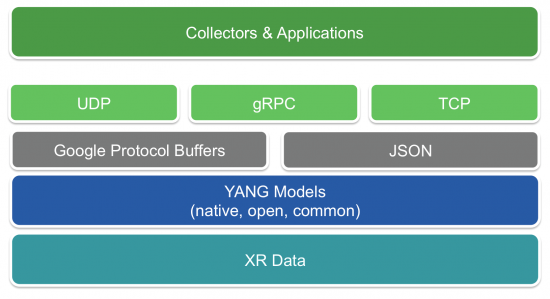































Co-written with Frederic Trate, Sr. Marketing Manager
Let me start by asking you a couple questions:
If you have answered yes to some of these questions, you likely need more data about your network and you need it much faster!
Let's be candid here -gone are the days when a network engineer could understand the network by typing CLI and eyeballing the results. Automation is the only way to manage the scale and complexity of today's large networks.
For the last 25 years, network operators have heavily relied on SNMP polling and CLI screen-scraping to extract operational data from the network. But the new and automated demands of today's networks have pushed these mechanisms to the breaking point.
Network operators often poll data from their network on the order of every five to thirty minutes. With careful tuning and testing, the bravest can push that interval down to one minute. But with today's speeds and scales, even that's not low enough to capture important network events. And as we move to higher density platforms, the amount of important operational data becomes truly staggering.
I bet what I've just described rings a bell to you, doesn't it? Wouldn't it be the right time to look at a new approach?

Telemetry was born of the question "How can we get as much data off the router as fast as possible in a way that makes it easy to use?"
As a first step, we needed to get rid of the inefficiencies associated with a polling mechanism like SNMP. Network operators poll periodically because they want the data at regular intervals. So why not just send them the data they want when they want it and skip the overhead of polling? Thus the idea of "streaming" was born.
Instead of pulling data off the network, sit back and let the network push it to you.
Of course, it's not enough to just push a lot of data off the device. Telemetry data must be structured in a sensible way to make it easy for monitoring tools to ingest. In other words, good telemetry data must be model-based.
The good news is that the networking industry has converged on YANG as a data modeling language for networking data, making it the natural choice for telemetry. Whether you prefer your data in native, OpenConfig or IETF YANG models, model-driven telemetry will deliver it to you.

Model-Driven Telemetry
Of course, you want all this data to be easy to use because you know that sooner or later someone will come to your desk and ask for Data Analytics.
Telemetry data needs to be normalized for efficient consumption by Big Data tools. In the software world, encodings such as JSON and Google Protocol Buffers (GPB) are widely used to transfer data between software applications. These encodings have an abundance of open-source software APIs that make it easy to manipulate and analyze the data.
By making network data available in these formats we give you a toolkit to open up a whole new world of Big Data analytics.
All kinds of applications can benefit from the deep knowledge that model-driven telemetry delivers. We have created open source example scripts and collectors to enable you to quickly take advantage of this new way of exporting network data. Because of the simple, popular encodings and underlying YANG data models, telemetry can also be integrated into existing monitoring tools.
Model-driven telemetry is your first step in a journey that will transform how you monitor and operate networks. With the power of telemetry, you'll discover things you never imagined and begin to ask more and better questions.
Network analytics is the new frontier. Start experiencing it today with Cisco IOS XR release 6.0.0. Consult Cisco.com documentation or your Cisco representative for the latest details on hardware platform support.
 Etiquetas calientes:
Análisis de análisis
IOS XR
YANG
telemetry
OpenConfig
data models
monitoring
Model-Driven
Etiquetas calientes:
Análisis de análisis
IOS XR
YANG
telemetry
OpenConfig
data models
monitoring
Model-Driven